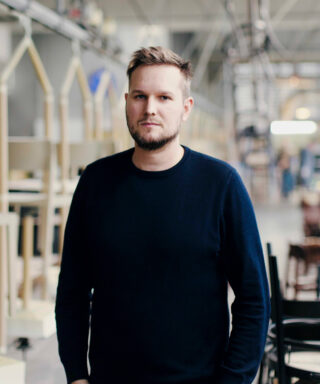Sebastian Herkner
Carbon footprint of Stammtisch
Sebastion Herkner draws inspiration directly from the trunk of the tree in the “simple”, “honest” and “pragmatic” Stammtisch design. This inspiration contributes to a very strong environmental profile. A very high proportion (99%) of the finished furniture comprises sustainable wood products, carefully crafted to minimise the need for glues and fixings. There is very high conversion efficiency so that 91% of the wood delivered to Benchmark is incorporated in the finished product, maximising carbon storage. Low energy input during manufacturing and Benchmark’s reliance on a renewable energy supplier further reduce the carbon footprint.
This inspiration contributes to a very strong environmental profile
The carbon footprint of Stammtisch is -(minus)71 kg CO2 eq., implying the design is better than carbon neutral. Total carbon emissions of 193 kg CO2 eq. are offset by 7 kg CO2 eq. due to burning of wood offcuts at Benchmark (which substituted for fossil fuel) and 257 kg CO2 eq. of carbon stored in the wood. This is sufficient to offset a 555 km drive in a typical family car or 3 days of carbon emissions by the average EU citizen. It takes only 0.3 seconds for the 162 kg of red oak and 16 kg of maple needed to manufacture Stammtisch to be replaced by regrowth in the U.S. forest.
It takes only 0.3 seconds for the red oak and maple needed to manufacture Stammtisch to be replaced by regrowth in the U.S. forest
Despite the distances involved, transport accounts for only 10% of all emissions associated with the design. The carbon footprint is much more sensitive to other factors, such as waste and energy mix during manufacturing, than to transport distance. The environmental benefit of a beautifully crafted and timeless design in sustainable natural wood is enhanced by the likelihood of it remaining in use for many years, avoiding the need for replacement and ensuring that carbon remains locked in Stammtisch far into the future.
